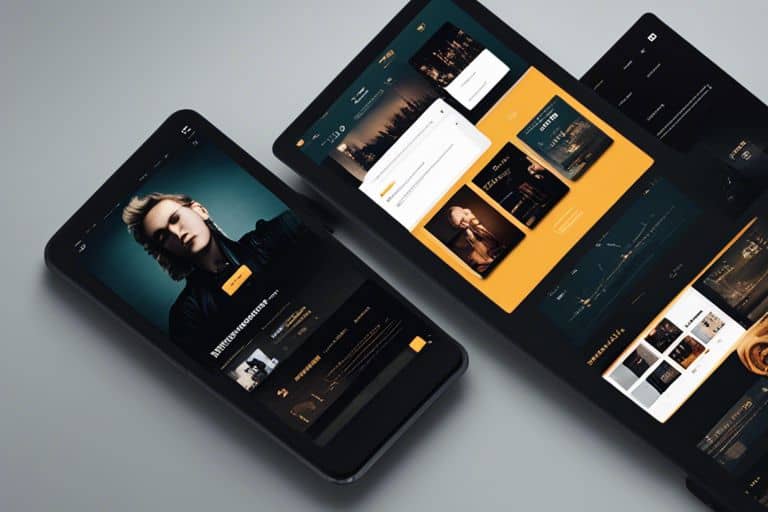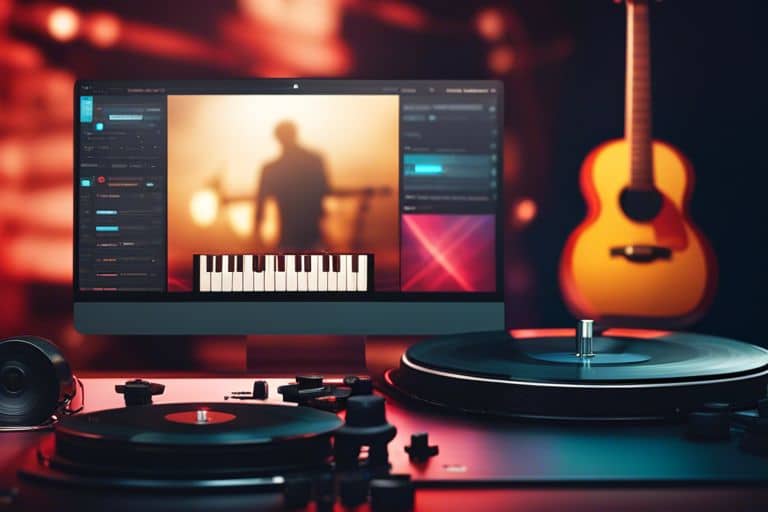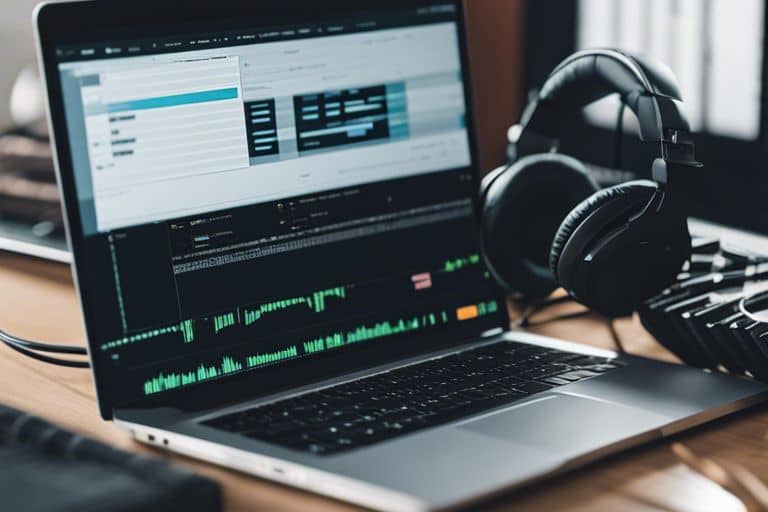
You, as a musician, know the importance of having a strong online presence to connect with fans and promote your music. A well-designed website is a powerful tool that can help you achieve your goals. In this guide, we will walk you through the important elements of effective web design for musicians, from creating a compelling homepage to optimizing your site for mobile users. For more in-depth information on building an affordable and successful music website, check out How to Build an Effective & Affordable Music Website.
Types of Musician Websites
While creating a website for your music career, it’s vital to consider the type of website that best suits your needs. Depending on your goals and the services you offer, different types of musician websites can be tailored to maximize your online presence. Here are the most common types of musician websites:
| Artist Portfolios | E-commerce and Merchandise Shops |
|---|---|
| Music Streaming Platforms | Tour Information Centers |
| Fan Engagement Hubs |
Artist Portfolios
An artist portfolio website is a digital showcase of a musician’s work, including music, videos, photos, and biographical information. It serves as a comprehensive online resume for artists to display their talent and attract potential collaborators or opportunities. Through a well-designed artist portfolio, musicians can establish their brand identity and impress industry professionals or fans with their creativity and skills.
Creating an artist portfolio requires a balance of visual appeal and informative content. High-quality images, audio samples, and videos should be prominently featured to engage visitors and showcase the artist’s work effectively. Additionally, providing a biography, discography, and upcoming events can give audiences a deeper insight into the artist’s background and career trajectory.
E-commerce and Merchandise Shops
Ecommerce platforms enable musicians to sell music, merchandise, concert tickets, and more directly to their fans online. This type of website is crucial for generating revenue and strengthening the relationship between artists and supporters. By offering exclusive products and limited-edition items, musicians can create a sense of exclusivity and incentivize fans to make purchases to support their favorite artists.
The integration of an e-commerce platform requires careful planning and execution to ensure a seamless shopping experience for users. From secure payment gateways to inventory management, e-commerce and merchandise shops play a significant role in monetizing a musician’s online presence and diversifying their income streams.
The e-commerce and merchandise section on a musician’s website should be user-friendly and visually appealing to encourage fans to explore and make purchases. By strategically promoting products and offering discounts or bundles, artists can drive sales and cultivate a dedicated fan base that supports their music career.
Music Streaming Platforms
To reach a broad audience and increase visibility, musicians can leverage music streaming platforms like Spotify, Apple Music, and SoundCloud. These platforms allow artists to share their music globally, connect with listeners, and potentially earn royalties based on the number of streams. By creating a profile on popular streaming services, musicians can expand their reach and attract new fans who discover their music organically.
To optimize a presence on music streaming platforms, artists should focus on creating high-quality recordings, engaging album artwork, and compelling artist bios. By regularly updating their profiles with new releases and promoting their music through playlists and collaborations, musicians can boost their streaming numbers and enhance their online credibility in the music industry.
Any musician looking to build a sustainable music career should prioritize establishing a presence on music streaming platforms to increase their visibility and reach a global audience. By leveraging the resources and promotional tools offered by these platforms, artists can effectively market their music and build a loyal fan base over time.
Tour Information Centers
On the tour information centers, artists can provide details about upcoming concerts, ticket availability, venue information, and tour dates. This section of a musician’s website is crucial for keeping fans informed about live performances and creating excitement around scheduled shows. By centralizing tour information in one dedicated section, artists can streamline the concert experience for fans and drive ticket sales effectively.
Information like tour schedules, ticket links, VIP packages, and venue directions should be clearly presented on the tour information center. Artists can also use this section to engage with fans through exclusive tour content, behind-the-scenes footage, and meet-and-greet opportunities to enhance the concert experience and foster a sense of community among supporters.
Fan Engagement Hubs
Hubs Fans Engagement hubs are interactive platforms where musicians can connect with their fans, share exclusive content, and cultivate a loyal fan base. These hubs serve as digital fan clubs where supporters can access behind-the-scenes footage, unreleased music, merchandise discounts, and virtual events. By creating a sense of exclusivity and offering unique benefits to fans, artists can strengthen their relationship with their audience and foster a dedicated community around their music.
Portfolios While Artist portfolios, e-commerce and merchandise shops, music streaming platforms, tour information centers, and fan engagement hubs are vital types of musician websites that cater to different aspects of an artist’s career and fan base. By strategically incorporating these elements into their online presence, musicians can create a comprehensive and engaging website that showcases their talent, promotes their music, and cultivates a dedicated fan following for long-term success in the music industry.
Step-by-Step Guide to Creating Your Music Website
| 1. Define Your Brand and Image | 2. Choose the Right Domain and Host |
Defining Your Brand and Image
Your music website is an vital reflection of your brand and image as a musician. Take the time to define what makes you unique and incorporate that into the design and content of your site. Consider your genre, style, and target audience to create a cohesive brand identity that resonates with visitors.
Your brand should be evident in every aspect of your website, from the color scheme and imagery to the fonts and language used. Make sure your brand message is clear and consistent throughout the site to establish a memorable and engaging online presence.
Choosing the Right Domain and Host
Website hosting and domain name selection are crucial to the success of your music website. Your domain name should be easy to remember, relevant to your music, and ideally include your artist or band name. Choose a reliable hosting provider that offers good uptime, fast loading speeds, and excellent customer support to ensure your website runs smoothly.
Guide: When deciding on a domain, consider using a reputable domain registrar like GoDaddy or Namecheap, and opt for a hosting plan that suits your website’s needs, whether it’s shared hosting, VPS, or dedicated hosting.
Selecting a Web Design Platform
Domain: The web design platform you choose will impact the functionality and aesthetics of your music website. Consider platforms like WordPress, Wix, or Squarespace that offer easy customization options, responsive design templates, and music-friendly features such as event calendars and music players.
Image: Look for a platform that allows you to showcase your music in an appealing way while providing a seamless user experience for visitors navigating your site.
Designing the User Experience
Right: When designing your music website, prioritize the user experience to ensure visitors can easily find and enjoy your music. Create a clear navigation structure, include intuitive search functionalities, and optimize your site for fast loading speeds to keep users engaged.
With a user-centric design approach, you can guide visitors through your site seamlessly, making it effortless for them to discover your music, upcoming events, and other relevant content.
Integrating Music and Multimedia Content
Experience: Enhance your music website by integrating multimedia content such as music videos, photo galleries, and audio clips. Create a multimedia-rich experience for visitors by embedding music players, linking to your social media channels, and showcasing your latest releases and performances.
Design: By incorporating multimedia elements into your website, you can engage with your audience on a deeper level and create an immersive online environment that reflects your artistry and creativity.
Optimizing for Mobile Devices
Website: With the increasing use of mobile devices, it’s vital to optimize your music website for mobile responsiveness. Choose a responsive web design that adapts to different screen sizes and ensures a seamless browsing experience for mobile users.
Selecting a mobile-friendly design will improve your website’s accessibility and reach, catering to a broader audience of music lovers who prefer to browse on their smartphones and tablets.

Tips for Effective Web Design
Unlike other industries, creating a visually appealing website for musicians requires a unique approach. Here are some tips to help you design an effective website that resonates with your audience:
- Keeping Design Simple and Clean
- Ensuring Site Navigation Is Intuitive
- Using High-Quality Images and Videos
- Updating Content Regularly
- SEO Best Practices for Musicians
Keeping Design Simple and Clean
Clean design is key to a successful musician’s website. When visitors land on your page, they should immediately be drawn to the content without distractions. A clutter-free layout with easy-to-read fonts and a cohesive color scheme can enhance the user experience and keep them engaged.
To maintain simplicity, limit the use of flashy graphics and animations. Focus on showcasing your music and brand identity through a clean and well-organized design.
Ensuring Site Navigation Is Intuitive
An intuitive navigation system is crucial for helping visitors find their way around your website. Use clear menu labels and organize your content logically to make it easy for users to access information. Consider implementing a search bar for quick access to specific pages.
Design your website in a way that guides visitors through the journey you want them to take. Make sure important pages like your bio, music, and upcoming events are easily accessible from any part of the site.
Assume that visitors may not spend a lot of time exploring your website, so make it effortless for them to find what they are looking for quickly.
Using High-Quality Images and Videos
Using high-quality images and videos can significantly enhance the visual appeal of your website. Professional photos, album covers, and music videos can help create a strong visual identity for your brand. Make sure that all multimedia elements are optimized for fast loading times to prevent slow page speed.
Embedding music videos or live performance footage can give visitors a taste of your music style and stage presence. Including a gallery of high-resolution images can also provide a glimpse into your life as a musician.
Videos play a significant role in engaging visitors and can increase the time they spend on your site. Consider adding behind-the-scenes footage, interviews, or music videos to create a dynamic and immersive experience for your audience.
Updating Content Regularly
Keeping your website content fresh and up to date is crucial for retaining visitor interest and improving search engine rankings. Regularly updating your music releases, tour dates, blog posts, and news can show that your website is active and relevant.
Updating your content not only keeps visitors coming back for more but also signals to search engines that your website is current and deserving of a higher ranking. Consider adding a blog section to share updates, music insights, and personal stories with your audience.
This can boost your SEO efforts and help attract organic traffic to your site. Including relevant keywords, meta descriptions, and alt text for images can also improve your website’s visibility on search engine results pages.
Factors to Consider When Designing Your Website
Not all websites are created equal, especially when it comes to effective web design for musicians. There are several important factors to consider to ensure that your website is engaging, user-friendly, and aligned with your brand and goals.
Audience Demographics
Brand Consistency
Loading Speed and Performance
Cross-Browser Compatibility
Analytics and Feedback Mechanisms
Audience Demographics
For musicians, understanding your audience demographics is crucial when designing a website. Knowing who your fans are, their age group, location, preferences, and online behavior can help tailor your website to meet their needs and expectations. This knowledge will influence the design, content, and overall user experience of your site.
Furthermore, audience demographics can also guide your marketing efforts, such as targeted advertising campaigns and content creation strategies to attract and engage with your fans successfully.
Brand Consistency
To establish a strong online presence, brand consistency across all platforms is key for musicians. Your website should reflect your unique brand identity, including logo, color scheme, fonts, and tone of voice. Consistency in branding helps build trust and recognition among your audience.
Plus, maintaining brand consistency reinforces professionalism and credibility, which can positively impact how your music is perceived by fans, industry professionals, and the media. This cohesive branding strategy can set you apart from competitors and create a memorable impression.
One of the vital elements in web design for musicians is loading speed and performance. A fast-loading website ensures a smooth user experience, reduces bounce rates, and improves search engine rankings. Optimize your website by compressing images, minimizing HTTP requests, and utilizing caching mechanisms to enhance loading speed and overall performance.
Designing your website with loading speed and performance in mind will not only benefit user engagement but also contribute to the overall success of your online presence. Note, every second counts in the digital world, and a slow website can deter potential fans and impact your music career.
Cross-Browser Compatibility
With the multitude of web browsers available, ensuring cross-browser compatibility is vital for reaching a broader audience. Your website should be optimized to display correctly across different browsers and devices, including mobile phones and tablets. Consistent user experience across various platforms enhances accessibility and usability for all visitors.
A responsive design approach can help achieve cross-browser compatibility, adapting your website layout and content to fit different screen sizes and resolutions seamlessly. By prioritizing cross-browser compatibility, you can maximize your website’s reach and ensure that all users have a positive interaction with your music content.
Mechanisms such as analytics and feedback tools are vital for monitoring your website’s performance, user behavior, and collecting valuable insights. Implementing analytics software can help track website traffic, engagement metrics, and conversion rates, allowing you to make data-driven decisions to optimize your site further.
Consistency in analyzing website data and gathering user feedback provides valuable information for continuous improvement and refinement of your online platform. These mechanisms offer valuable insights into your audience’s preferences, behaviors, and areas for enhancement, ultimately enhancing the effectiveness of your web design for musicians.
Pros and Cons of DIY vs. Professional Web Design
Despite the plethora of DIY website builders available today, many musicians struggle with the decision of whether to design their own website or hire a professional. Each option has its own set of advantages and disadvantages that should be carefully considered before making a choice.
| DIY | Professional |
| Cost-effective | Higher upfront cost |
| Creative control | Expertise in design and functionality |
| Quick setup | Time-consuming process |
| Limited customization | Scalable for future growth |
| Potential for errors | Professional look and feel |
Budget Considerations
Any decision regarding web design should consider the budget constraints of musicians. DIY options may seem more cost-effective initially, but hidden costs and limitations could arise in the long run. On the other hand, hiring a professional may require a higher upfront investment, but it can result in a more polished and effective website.
Time and Expertise
Considerations about time and expertise are crucial when deciding between DIY and professional web design. Musicians with limited time and technical skills may find it challenging to create a high-quality website on their own. Professionals, on the other hand, bring expertise in design, functionality, and user experience to the table.
To ensure the website effectively represents the musician’s brand and meets the desired goals, considering the time commitment and technical knowledge required is imperative.
Customization and Scalability
Expertise in web design plays a key role in the customization and scalability of a musician’s website. DIY platforms may offer limited customization options, hindering the ability to create a unique online presence. In contrast, professionals can tailor the website to the musician’s specific needs and ensure scalability for future growth.
A tailored website created by a professional can enhance the user experience and provide the flexibility needed to adapt to changing requirements over time.
Support and Maintenance
Any decision about web design should also consider the ongoing support and maintenance required to keep the website running smoothly. While DIY platforms often provide basic support, handling technical issues and updates can be overwhelming for musicians. Professionals offer maintenance services and technical support, ensuring the website remains secure and up to date.
The peace of mind that comes with professional support can alleviate the burden of website maintenance and allow musicians to focus on their craft without worrying about technical challenges.
Summing up
As a reminder, the key to effective web design for musicians lies in creating a visually appealing, user-friendly, and engaging website that showcases their music and brand. By incorporating these necessary elements like high-quality visual content, clear navigation, a responsive design, and seamless integration with social media, musicians can attract and engage their fans, ultimately driving more traffic and boosting their online presence. Following the tips and strategies outlined in this guide will help musicians create a strong online presence and connect with their audience in a meaningful way.
Continue reading
Purely you



Leave a Reply